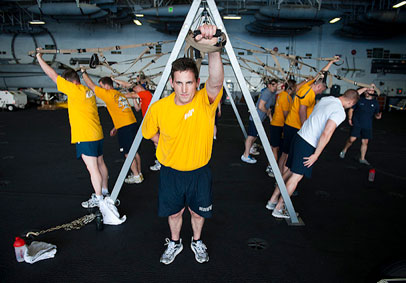The Consortium for Health and Military Performance (CHAMP) specializes in creating resources that support holistic health, resilience, and optimized performance for Service Members and their families, so they can attain human performance optimization (HPO). HPO is an optimal state of readiness that helps you perform your best for any goal or mission—whether you’re deployed in combat operations, training for Physical Fitness (PFT) and Physical Readiness Tests (PRT), or raising children.
Total Force Fitness and health
Your health isn’t just physical or something to worry about when you’re sick; it’s the foundation for sustaining HPO. The 2010 article “Why Total Force Fitness” (TFF) states, “nothing works without health.” Health is holistic. It requires a focus on physical, mental, spiritual, and social practices that promote wellness, prevent health decline, and help you recover quickly from illness and injury. TFF serves as a “holistic” compass that helps guide your efforts as you focus on those domains that are key to maintaining your health and sustaining HPO. CHAMP explores how to sustain the optimal well-being and performance of Warfighters, military families, and those organizations that serve them under all conditions and across all areas of TFF.
Resilience and recovery
Everyone faces stress from time to time, and others endure trauma. Resilience is how you react, respond, and adapt to that stress or trauma. It’s your capacity to thrive after experiencing hardship. Resilience isn’t just about your ability to completely endure hardship, but rather how you cope and grow stronger from your experience.
Precision-performance optimization
Holistic health and resilience combined with a precision-performance mindset are the foundations of HPO. And HPO isn’t just for individuals; it’s also for families and organizations. People have different goals, jobs, and responsibilities, so reaching and maintaining an optimal level of performance is different for everyone. What it takes for you to optimize your own performance depends upon your mission-essential tasks, knowledge, skills, abilities, any demands you’re facing, and supports you have in place. Since it’s specialized and different for everyone, it’s called “precision performance.” HPO goes beyond simply overcoming challenges such as an injury or illness; it means functioning at an even greater level to succeed and face new challenges.
This is where CHAMP’s Human Performance Resource Center (HPRC) website can help you on your quest for optimal performance. Visit each domain—Total Force Fitness, Physical Fitness, Nutrition, Family & Relationships, Mental Fitness, Environment, and Dietary Supplements—for evidence-based information on a variety of topics to help you achieve and sustain HPO.
Debrief
HPO isn’t just about you; your loved ones are an important part of completing that picture too. The health, resilience, and performance of your family, friends, and community also impact your ability to achieve and sustain HPO. Remember that reaching and maintaining HPO is a lifelong process that will change, depending on where you’re at in your career and life. At certain times, one or more domains of total fitness will require more attention than others, based on the shifting demands of your life. To promote your own resilience, try to focus on those areas as best as possible.
